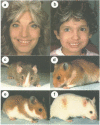Abstract
Four different Waardenburg syndromes have been defined based upon observed phenotypes. These syndromes are responsible for approximately 2% of subjects with profound congenital hearing loss. At present, Waardenburg syndromes have not been mapped to particular human chromosomes. One or more of the mouse mutant alleles, Ph (patch), s (piebald), Sp (splotch), and Mior (microphthalmia-Oak Ridge) and the hamster mutation Wh (anophthalmic white) may be homologous to mutations causing Waardenburg syndromes. In heterozygotes, phenotypic effects of these four mouse mutations and the hamster mutation are similar to the phenotypes produced by different Waardenburg syndrome mutations. The chromosomal locations and syntenic relationships associated with three of the four mouse mutant genes have been used to predict human chromosomal locations for Waardenburg syndromes: (1) on chromosome 2q near FN1 (fibronectin 1), (2) on chromosome 3p near the proto-oncogene RAF1 or 3q near RHO (rhodopsin), and (3) on chromosome 4p near the proto-oncogene KIT. Waardenburg syndromes show extensive intrafamilial phenotypic variability. Results of our studies with the hamster mutation Wh suggest that this variability may be explained in part by modifier genes segregating within families.
Full text
PDF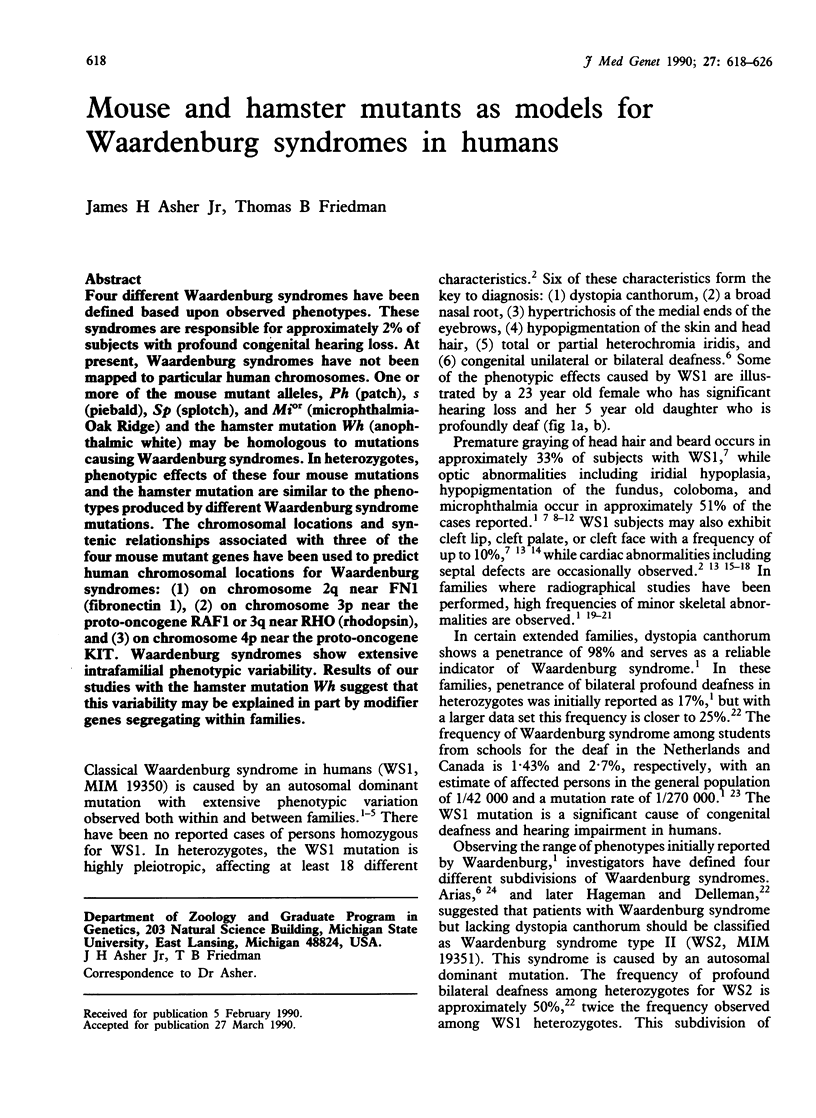
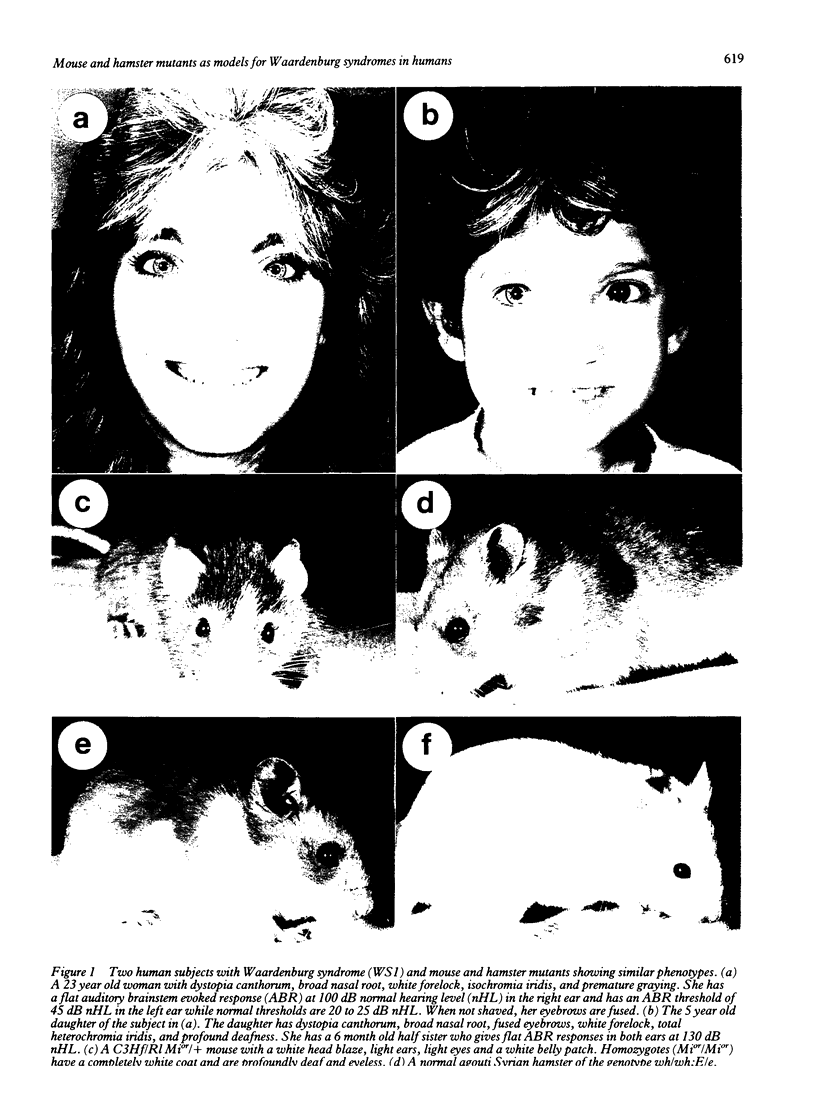
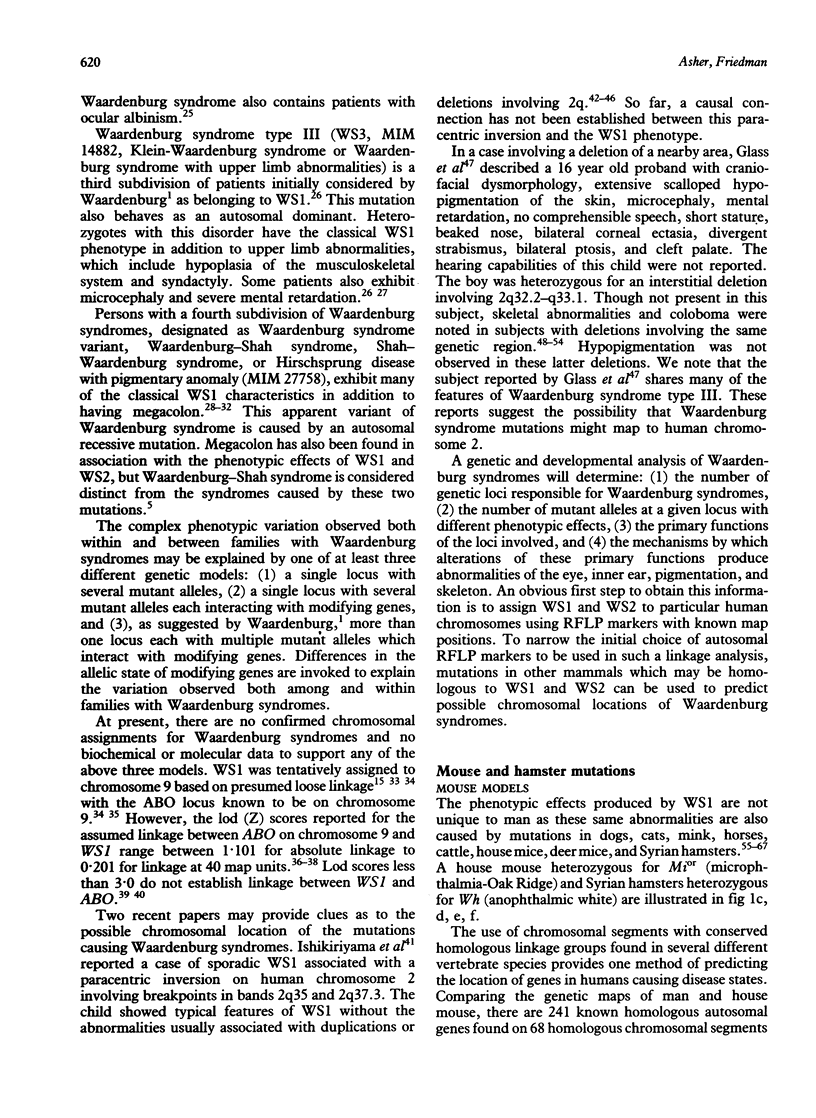
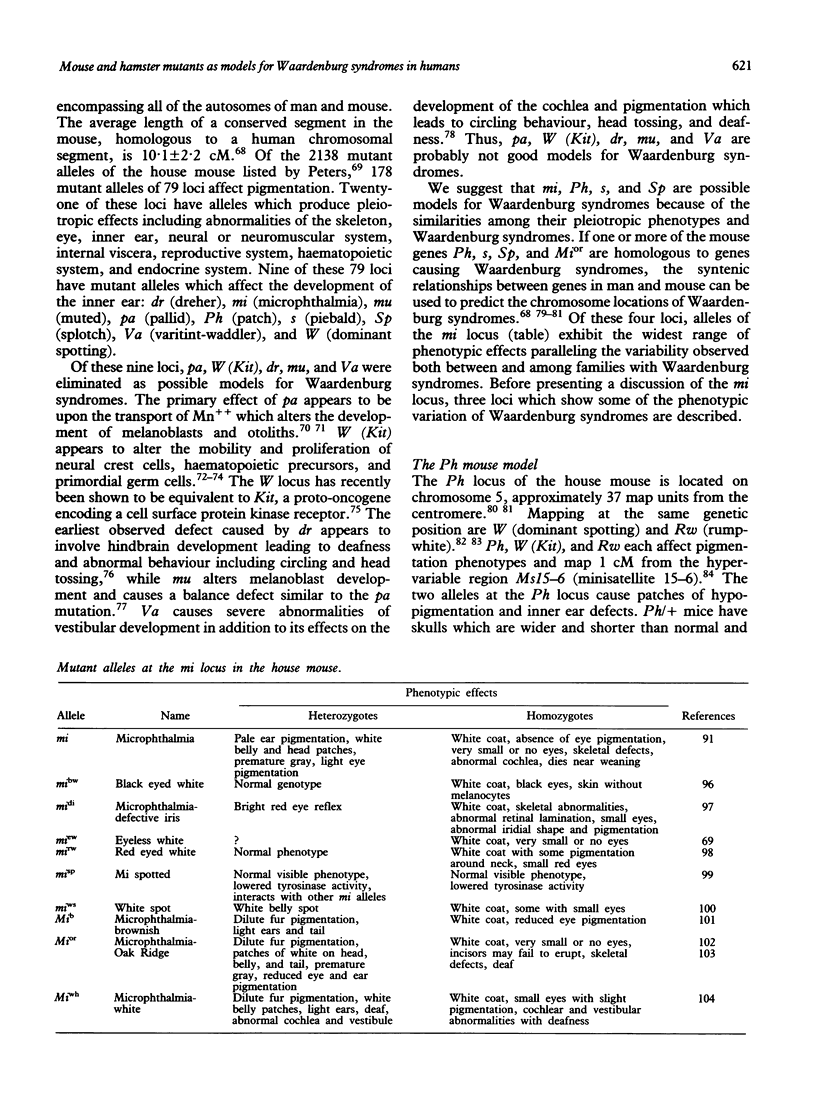
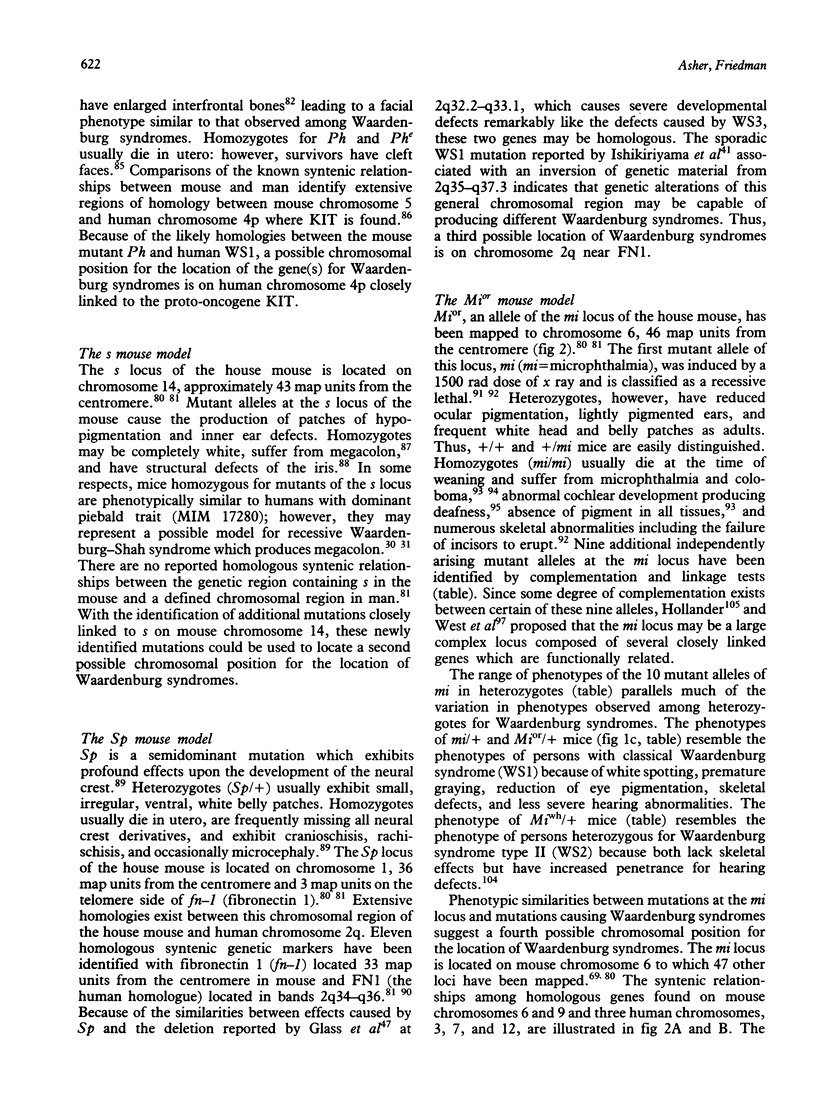
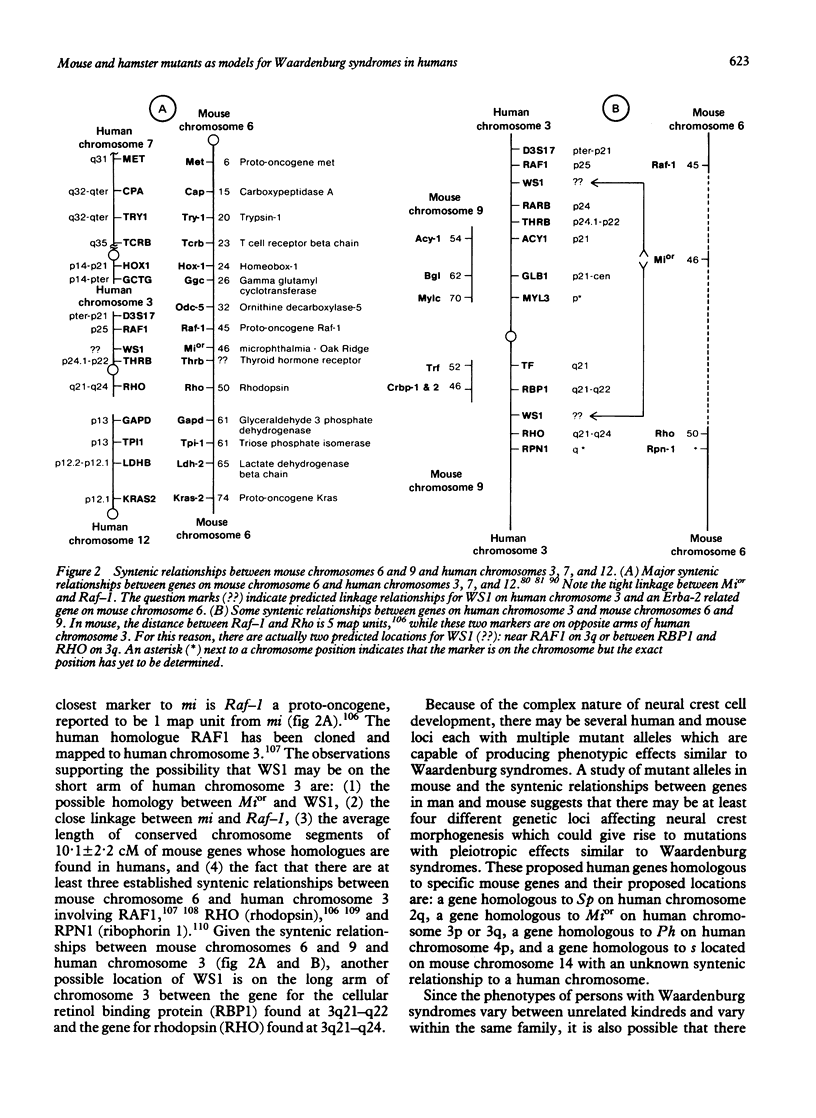
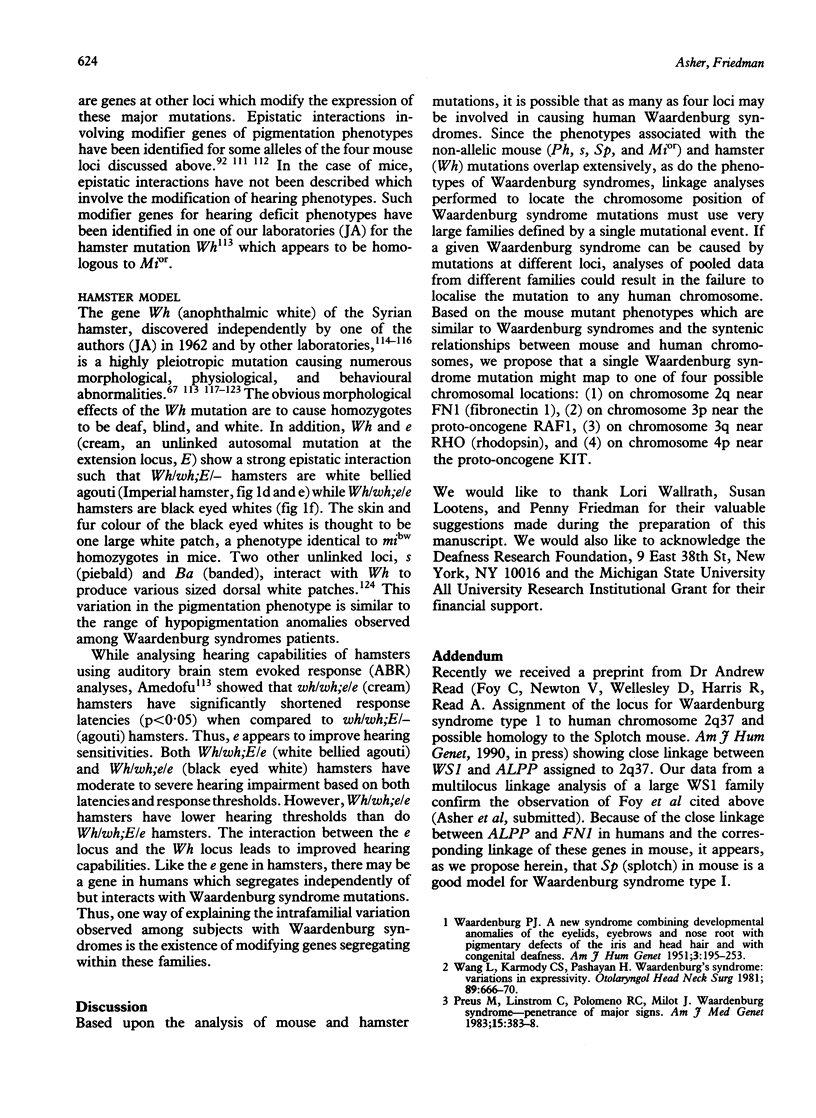
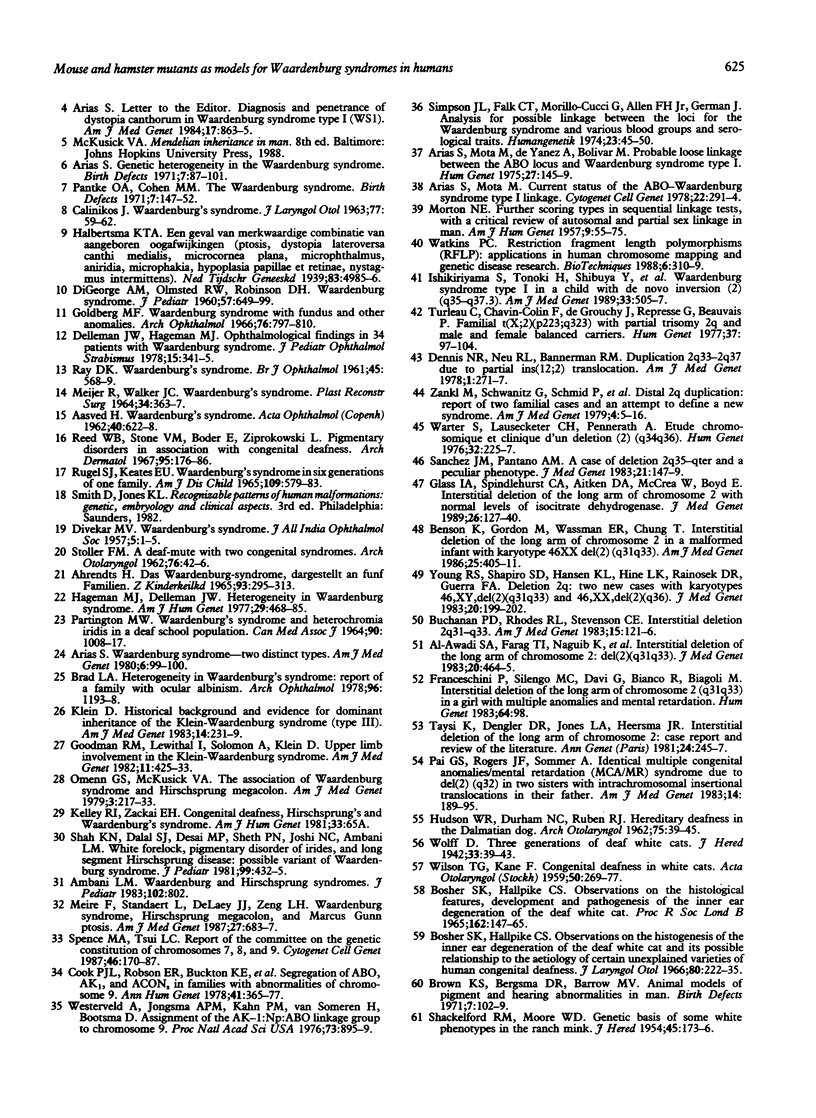
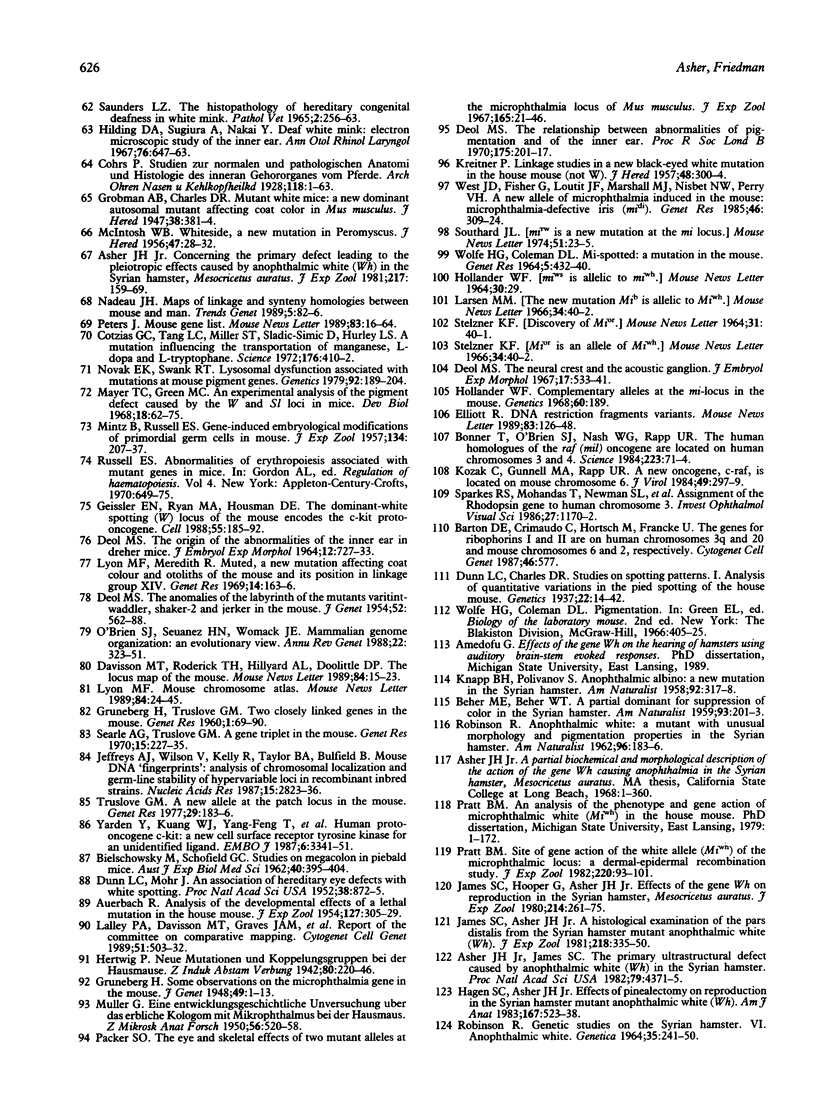
Images in this article
Selected References
These references are in PubMed. This may not be the complete list of references from this article.
- Al-Awadi S. A., Farag T. I., Naguib K., Teebi A., Cuschieri A., Al-Othman S., Sundareshan T. S. Interstitial deletion of the long arm of chromosome 2: del(2)(q31q33). J Med Genet. 1983 Dec;20(6):464–465. doi: 10.1136/jmg.20.6.464. [DOI] [PMC free article] [PubMed] [Google Scholar]
- Ambani L. M. Waardenburg and Hirschsprung syndromes. J Pediatr. 1983 May;102(5):802–802. doi: 10.1016/s0022-3476(83)80267-4. [DOI] [PubMed] [Google Scholar]
- Arias S. Diagnosis and penetrance of dystopia canthorum in Waardenburg syndrome type I (WS1) Am J Med Genet. 1984 Apr;17(4):863–867. doi: 10.1002/ajmg.1320170423. [DOI] [PubMed] [Google Scholar]
- Arias S. Genetic heterogeneity in the Waardenburg syndrome. Birth Defects Orig Artic Ser. 1971 Mar;07(4):87–101. [PubMed] [Google Scholar]
- Arias S., Mota M. Current status of the ABO-Waardenburg syndrome type I linkage. Cytogenet Cell Genet. 1978;22(1-6):291–294. doi: 10.1159/000130956. [DOI] [PubMed] [Google Scholar]
- Arias S., Mota M., Yánez A., Bolivar M. Probable loose linkage between the ABO locus and Waardenburg syndrome type I. Humangenetik. 1975;27(2):145–149. doi: 10.1007/BF00273330. [DOI] [PubMed] [Google Scholar]
- Arias S. Waardenburg syndrome--two distinct types. Am J Med Genet. 1980;6(1):99–100. doi: 10.1002/ajmg.1320060109. [DOI] [PubMed] [Google Scholar]
- Asher J. H., Jr Concerning the primary defect leading to the pleiotropic effects caused by anophthalmic white (Wh) in the Syrian hamster Mesocricetus auratus. J Exp Zool. 1981 Aug;217(2):159–169. doi: 10.1002/jez.1402170203. [DOI] [PubMed] [Google Scholar]
- Asher J. H., Jr, James S. C. The primary ultrastructural defect caused by anophthalmic white (Wh) in the Syrian hamster. Proc Natl Acad Sci U S A. 1982 Jul;79(14):4371–4375. doi: 10.1073/pnas.79.14.4371. [DOI] [PMC free article] [PubMed] [Google Scholar]
- BIELSCHOWSKY M., SCHOFIELD G. C. Studies on megacolon in piebald mice. Aust J Exp Biol Med Sci. 1962 Oct;40:395–403. doi: 10.1038/icb.1962.44. [DOI] [PubMed] [Google Scholar]
- Bard L. A. Heterogeneity in Waardenburg's syndrome. Report of a family with ocular albinism. Arch Ophthalmol. 1978 Jul;96(7):1193–1198. doi: 10.1001/archopht.1978.03910060027006. [DOI] [PubMed] [Google Scholar]
- Benson K., Gordon M., Wassman E. R., Tsi C. Interstitial deletion of the long arm of chromosome 2 in a malformed infant with karyotype 46,XX,del(2)(q31q33). Am J Med Genet. 1986 Nov;25(3):405–411. doi: 10.1002/ajmg.1320250302. [DOI] [PubMed] [Google Scholar]
- Bonner T., O'Brien S. J., Nash W. G., Rapp U. R., Morton C. C., Leder P. The human homologs of the raf (mil) oncogene are located on human chromosomes 3 and 4. Science. 1984 Jan 6;223(4631):71–74. doi: 10.1126/science.6691137. [DOI] [PubMed] [Google Scholar]
- Bosher S. K., Hallpike C. S. Observations on the histogenesis of the inner ear degeneration of the deaf white cat and its possible relationship to the aetiology of certain unexplained varieties of human congenital deafness. J Laryngol Otol. 1966 Mar;80(3):222–235. doi: 10.1017/s0022215100065191. [DOI] [PubMed] [Google Scholar]
- Brown K. S., Bergsma D. R., Barrow M. V. Animal models of pigment and hearing abnormalities in man. Birth Defects Orig Artic Ser. 1971 Mar;07(4):102–109. [PubMed] [Google Scholar]
- Buchanan P. D., Rhodes R. L., Stevenson C. E., Jr Interstitial deletion 2q31 leads to q33. Am J Med Genet. 1983 May;15(1):121–126. doi: 10.1002/ajmg.1320150116. [DOI] [PubMed] [Google Scholar]
- Cook P. J., Robson E. B., Buckton K. E., Slaughter C. A., Gray J. E., Blank C. E., James F. E., Ridler M. A., Insley J., Hultén M. Segregation of ABO, AK1 and ACONs in families with abnormalities of chromosome 9. Ann Hum Genet. 1978 Jan;41(3):365–377. doi: 10.1111/j.1469-1809.1978.tb01904.x. [DOI] [PubMed] [Google Scholar]
- Cotzias G. C., Tang L. C., Miller S. T., Sladic-Simic D., Hurley L. S. A mutation influencing the transportation of manganese, L-dopa, and L-tryptophan. Science. 1972 Apr 28;176(4033):410–412. doi: 10.1126/science.176.4033.410. [DOI] [PubMed] [Google Scholar]
- DEOL M. S. THE ORIGIN OF THE ABNORMALITIES OF THE INNER EAR IN DREHER MICE. J Embryol Exp Morphol. 1964 Dec;12:727–733. [PubMed] [Google Scholar]
- DIGEORGE A. M., OLMSTED R. W., HARLEY R. D. Waardenburg's syndrome. A syndrome of heterochromia of the irides, lateral displacement of the medial canthi and lacrimal puncta, congenital deafness, and other characteristic associated defects. J Pediatr. 1960 Nov;57:649–669. doi: 10.1016/s0022-3476(60)80159-x. [DOI] [PubMed] [Google Scholar]
- Delleman J. W., Hageman M. J. Ophthalmological findings in 34 patients with Waardenburg syndrome. J Pediatr Ophthalmol Strabismus. 1978 Nov-Dec;15(6):341–345. doi: 10.3928/0191-3913-19781101-03. [DOI] [PubMed] [Google Scholar]
- Dennis N. R., Neu R. L., Bannerman R. M. Duplication 2q33 leads to 2q37 due to paternal ins (12;2) translocation. Am J Med Genet. 1978;1(3):271–277. doi: 10.1002/ajmg.1320010303. [DOI] [PubMed] [Google Scholar]
- Deol M. S. The neural crest and the acoustic ganglion. J Embryol Exp Morphol. 1967 Jun;17(3):533–541. [PubMed] [Google Scholar]
- Deol M. S. The relationship between abnormalities of pigmentation and of the inner ear. Proc R Soc Lond B Biol Sci. 1970 Apr 7;175(1039):201–217. doi: 10.1098/rspb.1970.0019. [DOI] [PubMed] [Google Scholar]
- Dunn L C, Charles D R. Studies on Spotting Patterns I. Analysis of Quantitative Variations in the Pied Spotting of the House Mouse. Genetics. 1937 Jan;22(1):14–42. doi: 10.1093/genetics/22.1.14. [DOI] [PMC free article] [PubMed] [Google Scholar]
- Dunn L. C., Mohr J. An Association of Hereditary Eye Defects with White Spotting. Proc Natl Acad Sci U S A. 1952 Oct;38(10):872–875. doi: 10.1073/pnas.38.10.872. [DOI] [PMC free article] [PubMed] [Google Scholar]
- Franceschini P., Cirillo Silengo M., Davi G., Bianco R., Biagioli M. Interstitial deletion of the long arm of chromosome 2 (q31q33) in a girl with multiple anomalies and mental retardation. Hum Genet. 1983;64(1):98–98. doi: 10.1007/BF00289489. [DOI] [PubMed] [Google Scholar]
- Geissler E. N., Ryan M. A., Housman D. E. The dominant-white spotting (W) locus of the mouse encodes the c-kit proto-oncogene. Cell. 1988 Oct 7;55(1):185–192. doi: 10.1016/0092-8674(88)90020-7. [DOI] [PubMed] [Google Scholar]
- Glass I. A., Swindlehurst C. A., Aitken D. A., McCrea W., Boyd E. Interstitial deletion of the long arm of chromosome 2 with normal levels of isocitrate dehydrogenase. J Med Genet. 1989 Feb;26(2):127–130. doi: 10.1136/jmg.26.2.127. [DOI] [PMC free article] [PubMed] [Google Scholar]
- Goldberg M. F. Waardenburg's syndrome with fundus and other anomalies. Arch Ophthalmol. 1966 Dec;76(6):797–810. doi: 10.1001/archopht.1966.03850010799005. [DOI] [PubMed] [Google Scholar]
- Goodman R. M., Lewithal I., Solomon A., Klein D. Upper limb involvement in the Klein-Waardenburg syndrome. Am J Med Genet. 1982 Apr;11(4):425–433. doi: 10.1002/ajmg.1320110407. [DOI] [PubMed] [Google Scholar]
- Hageman M. J., Delleman J. W. Heterogeneity in Waardenburg syndrome. Am J Hum Genet. 1977 Sep;29(5):468–485. [PMC free article] [PubMed] [Google Scholar]
- Hagen S. C., Asher J. H., Jr Effects of pinealectomy on reproduction in the Syrian hamster mutant anophthalmic white (Wh). Am J Anat. 1983 Aug;167(4):523–538. doi: 10.1002/aja.1001670408. [DOI] [PubMed] [Google Scholar]
- Hilding D. A., Sugiura A., Nakai Y. Deaf white mink: electron microscopic study of the inner ear. Ann Otol Rhinol Laryngol. 1967 Aug;76(3):647–663. doi: 10.1177/000348946707600310. [DOI] [PubMed] [Google Scholar]
- Ishikiriyama S., Tonoki H., Shibuya Y., Chin S., Harada N., Abe K., Niikawa N. Waardenburg syndrome type I in a child with de novo inversion (2)(q35q37.3). Am J Med Genet. 1989 Aug;33(4):505–507. doi: 10.1002/ajmg.1320330419. [DOI] [PubMed] [Google Scholar]
- James S. C., Asher J. H., Jr A histological examination of the pars distalis from the Syrian hamster mutant Anophthalmic white (Wh). J Exp Zool. 1981 Dec;218(3):335–350. doi: 10.1002/jez.1402180305. [DOI] [PubMed] [Google Scholar]
- James S. C., Hooper G., Asher J. H., Jr Effects of the gene Wh on reproduction in the Syrian hamster, Mesocricetus auratus. J Exp Zool. 1980 Dec;214(3):261–275. doi: 10.1002/jez.1402140304. [DOI] [PubMed] [Google Scholar]
- Jeffreys A. J., Wilson V., Kelly R., Taylor B. A., Bulfield G. Mouse DNA 'fingerprints': analysis of chromosome localization and germ-line stability of hypervariable loci in recombinant inbred strains. Nucleic Acids Res. 1987 Apr 10;15(7):2823–2836. doi: 10.1093/nar/15.7.2823. [DOI] [PMC free article] [PubMed] [Google Scholar]
- Klein D. Historical background and evidence for dominant inheritance of the Klein-Waardenburg syndrome (type III). Am J Med Genet. 1983 Feb;14(2):231–239. doi: 10.1002/ajmg.1320140205. [DOI] [PubMed] [Google Scholar]
- Kozak C., Gunnell M. A., Rapp U. R. A new oncogene, c-raf, is located on mouse chromosome 6. J Virol. 1984 Jan;49(1):297–299. doi: 10.1128/jvi.49.1.297-299.1984. [DOI] [PMC free article] [PubMed] [Google Scholar]
- Lalley P. A., Davison M. T., Graves J. A., O'Brien S. J., Womack J. E., Roderick T. H., Creau-Goldberg N., Hillyard A. L., Doolittle D. P., Rogers J. A. Report of the committee on comparative mapping. Cytogenet Cell Genet. 1989;51(1-4):503–532. doi: 10.1159/000132806. [DOI] [PubMed] [Google Scholar]
- Lyon M. F., Meredith R. Muted, a new mutant affecting coat colour and otoliths of the mouse, and its position in linkage group XIV. Genet Res. 1969 Oct;14(2):163–166. doi: 10.1017/s0016672300002007. [DOI] [PubMed] [Google Scholar]
- MINTZ B., RUSSELL E. S. Gene-induced embryological modifications of primordial germ cells in the mouse. J Exp Zool. 1957 Mar;134(2):207–237. doi: 10.1002/jez.1401340202. [DOI] [PubMed] [Google Scholar]
- MORTON N. E. Further scoring types in sequential linkage tests, with a critical review of autosomal and partial sex linkage in man. Am J Hum Genet. 1957 Mar;9(1):55–75. [PMC free article] [PubMed] [Google Scholar]
- Mayer T. C., Green M. C. An experimental analysis of the pigment defect caused by mutations at the W and S1 loci in mice. Dev Biol. 1968 Jul;18(1):62–75. doi: 10.1016/0012-1606(68)90023-7. [DOI] [PubMed] [Google Scholar]
- Meire F., Standaert L., De Laey J. J., Zeng L. H. Waardenburg syndrome, Hirschsprung megacolon, and Marcus Gunn ptosis. Am J Med Genet. 1987 Jul;27(3):683–686. doi: 10.1002/ajmg.1320270322. [DOI] [PubMed] [Google Scholar]
- Nadeau J. H. Maps of linkage and synteny homologies between mouse and man. Trends Genet. 1989 Mar;5(3):82–86. doi: 10.1016/0168-9525(89)90031-0. [DOI] [PubMed] [Google Scholar]
- Novak E. K., Swank R. T. Lysosomal dysfunctions associated with mutations at mouse pigment genes. Genetics. 1979 May;92(1):189–204. doi: 10.1093/genetics/92.1.189. [DOI] [PMC free article] [PubMed] [Google Scholar]
- O'Brien S. J., Seuánez H. N., Womack J. E. Mammalian genome organization: an evolutionary view. Annu Rev Genet. 1988;22:323–351. doi: 10.1146/annurev.ge.22.120188.001543. [DOI] [PubMed] [Google Scholar]
- Omenn G. S., McKusick V. A. The association of Waardenburg syndrome and Hirschsprung megacolon. Am J Med Genet. 1979;3(3):217–223. doi: 10.1002/ajmg.1320030302. [DOI] [PubMed] [Google Scholar]
- PARTINGTON M. W. WAARDENBURG'S SYNDROME AND HETEROCHROMIA IRIDUM IN A DEAF SCHOOL POPULATION. Can Med Assoc J. 1964 Apr 25;90:1008–1017. [PMC free article] [PubMed] [Google Scholar]
- Packer S. O. The eye and skeletal effects of two mutant alleles at the microphthalmia locus of Mus musculus. J Exp Zool. 1967 Jun;165(1):21–45. doi: 10.1002/jez.1401650103. [DOI] [PubMed] [Google Scholar]
- Pai G. S., Rogers J. F., Sommer A. Identical multiple congenital anomalies/mental retardation (MCA/MR) syndrome due to del(2)(q32) in two sisters with intrachromosomal insertional translocation in their father. Am J Med Genet. 1983 Jan;14(1):189–195. doi: 10.1002/ajmg.1320140125. [DOI] [PubMed] [Google Scholar]
- Pantke O. A., Cohen M. M., Jr The Waardenburg syndrome. Birth Defects Orig Artic Ser. 1971 Jun;7(7):147–152. [PubMed] [Google Scholar]
- Pratt B. M. Site of gene action of the white allele (Miwh) of the microphthalmia locus: a dermal-epidermal recombination study. J Exp Zool. 1982 Mar 1;220(1):93–101. doi: 10.1002/jez.1402200112. [DOI] [PubMed] [Google Scholar]
- Preus M., Linstrom C., Polomeno R. C., Milot J. Waardenburg syndrome--penetrance of major signs. Am J Med Genet. 1983 Jul;15(3):383–388. doi: 10.1002/ajmg.1320150303. [DOI] [PubMed] [Google Scholar]
- ROBINSON R. GENETIC STUDIES OF THE SYRIAN HAMSTER. VI. ANOPHTHALMIC WHITE. Genetica. 1964;35:241–250. doi: 10.1007/BF01804891. [DOI] [PubMed] [Google Scholar]
- RUGEL S. J., KEATES E. U. WAARDENBURG'S SYNDROME IN SIX GENERATIONS OF ONE FAMILY. Am J Dis Child. 1965 Jun;109:579–583. doi: 10.1001/archpedi.1965.02090020581016. [DOI] [PubMed] [Google Scholar]
- Searle A. G., Truslove G. M. A gene triplet in the mouse. Genet Res. 1970 Apr;15(2):227–235. doi: 10.1017/s0016672300001555. [DOI] [PubMed] [Google Scholar]
- Shah K. N., Dalal S. J., Desai M. P., Sheth P. N., Joshi N. C., Ambani L. M. White forelock, pigmentary disorder of irides, and long segment Hirschsprung disease: possible variant of Waardenburg syndrome. J Pediatr. 1981 Sep;99(3):432–435. doi: 10.1016/s0022-3476(81)80339-3. [DOI] [PubMed] [Google Scholar]
- Simpson J. L., Falk C. T., Morillo-Cucci G., Allen F. H., Jr, German J. Analysis for possible linkage between the loci for the Waardenburg syndrome and various blood groups and serological traits. Humangenetik. 1974 Jun 26;23(1):45–50. doi: 10.1007/BF00295681. [DOI] [PubMed] [Google Scholar]
- Sparkes R. S., Mohandas T., Newman S. L., Heinzmann C., Kaufman D., Zollman S., Leveille P. J., Tobin A. J., McGinnis J. F. Assignment of the rhodopsin gene to human chromosome 3. Invest Ophthalmol Vis Sci. 1986 Jul;27(7):1170–1172. [PubMed] [Google Scholar]
- Spence M. A., Tsui L. C. Report of the committee on the genetic constitution of chromosomes 7, 8 and 9. Cytogenet Cell Genet. 1987;46(1-4):170–187. doi: 10.1159/000132476. [DOI] [PubMed] [Google Scholar]
- Sánchez J. M., Pantano A. M. A case of deletion 2q35----qter and a peculiar phenotype. J Med Genet. 1984 Apr;21(2):147–149. doi: 10.1136/jmg.21.2.147. [DOI] [PMC free article] [PubMed] [Google Scholar]
- Taysi K., Dengler D. R., Jones L. A., Heersma J. R. Interstitial deletion of the long arm of chromosome 2: case report and review of literature. Ann Genet. 1981;24(4):245–247. [PubMed] [Google Scholar]
- Truslove G. M. A new allele at the patch locus in the mouse. Genet Res. 1977 Apr;29(2):183–186. doi: 10.1017/s0016672300017249. [DOI] [PubMed] [Google Scholar]
- Turleau C., Chavin-Colin F., de Grouchy J., Repessé G., Beauvais P. Familial t(X;2) (p223;q323) with partial trisomy 2q and male and female balanced carriers. Hum Genet. 1977 Jun 10;37(1):97–104. doi: 10.1007/BF00293779. [DOI] [PubMed] [Google Scholar]
- WAARDENBURG P. J. A new syndrome combining developmental anomalies of the eyelids, eyebrows and nose root with pigmentary defects of the iris and head hair and with congenital deafness. Am J Hum Genet. 1951 Sep;3(3):195–253. [PMC free article] [PubMed] [Google Scholar]
- WILSON T. G., KANE F. Congenital deafness in white cats. Acta Otolaryngol. 1959 May-Aug;50(3-4):269–277. doi: 10.3109/00016485909129195. [DOI] [PubMed] [Google Scholar]
- Wang L., Karmody C. S., Pashayan H. Waardenburg's syndrome: variations in expressivity. Otolaryngol Head Neck Surg. 1981 Jul-Aug;89(4):666–670. doi: 10.1177/019459988108900428. [DOI] [PubMed] [Google Scholar]
- Warter S., Lausecker C., Pennerath A. Etude chromosomique et clinique d'und fillette porteuse d'une deletion (2) (q34q36) Hum Genet. 1976 May 19;32(2):225–227. doi: 10.1007/BF00291510. [DOI] [PubMed] [Google Scholar]
- Watkins P. C. Restriction fragment length polymorphism (RFLP): applications in human chromosome mapping and genetic disease research. Biotechniques. 1988 Apr;6(4):310-9, 322. [PubMed] [Google Scholar]
- West J. D., Fisher G., Loutit J. F., Marshall M. J., Nisbet N. W., Perry V. H. A new allele of microphthalmia induced in the mouse: microphthalmia--defective iris (midi). Genet Res. 1985 Dec;46(3):309–324. doi: 10.1017/s0016672300022801. [DOI] [PubMed] [Google Scholar]
- Westerveld A., Jongsma A. P., Meera Khan P., van Someren H., Bootsma D. Assignment of the AK1:Np:ABO linkage group to human chromosome 9. Proc Natl Acad Sci U S A. 1976 Mar;73(3):895–899. doi: 10.1073/pnas.73.3.895. [DOI] [PMC free article] [PubMed] [Google Scholar]
- Yarden Y., Kuang W. J., Yang-Feng T., Coussens L., Munemitsu S., Dull T. J., Chen E., Schlessinger J., Francke U., Ullrich A. Human proto-oncogene c-kit: a new cell surface receptor tyrosine kinase for an unidentified ligand. EMBO J. 1987 Nov;6(11):3341–3351. doi: 10.1002/j.1460-2075.1987.tb02655.x. [DOI] [PMC free article] [PubMed] [Google Scholar]
- Young R. S., Shapiro S. D., Hansen K. L., Hine L. K., Rainosek D. E., Guerra F. A. Deletion 2q: two new cases with karyotypes 46,XY,del(2)(q31q33) and 46,XX,del(2)(q36). J Med Genet. 1983 Jun;20(3):199–202. doi: 10.1136/jmg.20.3.199. [DOI] [PMC free article] [PubMed] [Google Scholar]
- Zankl M., Schwanitz G., Schmid P., Zankl H., Dockter G., Rodewald A., Zang K. D., Grosse K. P. Distal 2q duplication: report of two familial cases and an attempt to define a syndrome. Am J Med Genet. 1979;4(1):5–16. doi: 10.1002/ajmg.1320040103. [DOI] [PubMed] [Google Scholar]



